Related Research Articles
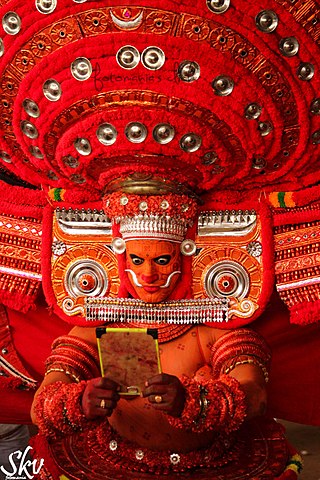
Theyyam is a Hindu religious ritual practiced in northern Kerala and some parts of Karnataka. Theyyam is also known as Kaḷiyāṭṭaṁ or Tiṟa. Theyyam consists of traditions, rituals and customs associated with temples and sacred groves of Malabar. The people of the region consider Theyyam itself as a channel to a god and they thus seek blessings from Theyyam.

Parassinikadavu Muthappan temple is a temple located at Parassinikadavu in Anthoor municipality on the banks of the Valapattanam river about 10 km (6.2 mi) from Taliparamba and 20 km (12 mi) from Kannur town in Kannur district, Kerala, India. Thiyya community urayima Principal deity of the temple is Sree Muthappan, whose divinity is presented as a ritualistic theyyam enactment in two versions called Thiruvappan and Vellattam. According to the local tradition the presiding deity is a manifestation of Lord Shiva.
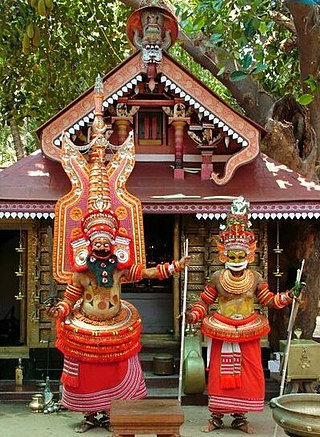
Muthappan is a deity commonly worshiped in the Kannur, Kasargod, Kozhikode, Malappuram region of Kerala and Coorg region of Karnataka in India. Muthappan is considered as the personification of two Hindu gods — the Thiruvappan or Valiya Muthapan (Vishnu) and the Vellatom or Cheriya Muthapan (Shiva).
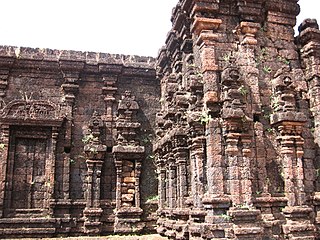
The Rajarajeshwara temple is a Shiva temple located in Taliparamba in Kannur district of Kerala State of India. The temple is regarded as one of the existing 108 ancient Shiva Temples of ancient Kerala. It also has a prominent place amongst the numerous Shiva temples in South India. It had the tallest shikhara amongst the temples of its time. The Rajarajeshwara temple has a top of about 90 tonnes. If any problem is encountered in the other temples of South India, devotees seek a solution in this temple through a prashnam, a traditional method of astrological decision-making. The prashnam is conducted on a peedha outside the temple.

Cherpu is a suburb of Thrissur city in the Kerala State of South India. It is 12 kilometres south of Thrissur town and is on the Thriprayar road. It is dotted by a number of temples and has quite a few rivers flowing by its vicinity.
Uthramvilakku is a temple festival celebrated at Edakkunni in Ollur, south of Thrissur in central Kerala, south India. The highlight of the event is an over four-hour Panchari melam in the temple compound past midnight on the uthram day, with each of the five caparisoned elephants on the occasion carrying a deity each from as many temples.

Nagaradhane is a form of serpent worship which, along with Bhuta Kola, is one of the unique traditions prevalent in coastal districts of Dakshina Kannada, Udupi and Kasaragod collectively known as Tulu Nadu, practiced by Tuluva community members. Cobras are not just seen as deities, but as an animal species which should be respected, appeased and protected for multiple social, religious and ecological reasons.
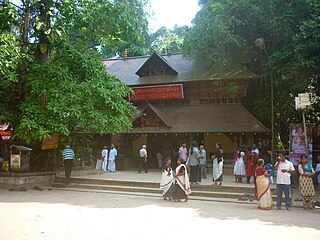
Mannarasala Sree Nagaraja Temple in Haripad is a very ancient and internationally known centre of pilgrimage for the devotees of serpent Gods (Nagaraja). The famous Nagaraja temple "Mannarasala" in Haripad is nestled in a forest glade, like most snake temples. The Mannarasala Temple has over 100,000 images of snakes along the paths and among the trees, and is the largest such temple in Kerala, India. Couples seeking fertility come to worship here, and upon the birth of their child come to hold thanksgiving ceremonies here, often bringing new snake images as offerings. A special turmeric paste which is available at the temple is credited with curative powers.

Poothan and Thira is a ritualistic folk art performed mainly in the Valluvanad region of central Kerala in India, in which people dance in costumes representing Poothan is the lieutenant of Kali, and Thira, the goddess Kali, to the accompaniment of drummers. Thudi a small drum using for poothan, and heavy drum para accompanying thira.
Theeyaattam also known as Theeyaattu (Tīyāttu) is a traditional temple dance form of Kerala.
Ivor Madom Parthasarathy Temple is a popular temple situated in Pampady village near Thiruvilwamala in Thrissur district, on the southern bank of Bharathappuzha, the second longest river of Kerala. The main deity of this temple is Lord Krishna as Parthasarathy, and there are sub-shrines for Ganapathi, Ayyappan, Shiva and Snake deities. The riverside near this temple is famous for performing rituals for dead ancestors. There is also a crematorium, jointly owned by Ivor Madom trust and Thiruvilwamala Grama Panchayat, near this temple.
There are places of worship considered important in the Kannur district. Kannur District is one of the 14 districts in the state of Kerala, India. The town of Kannur is the district headquarters, and gives the district its name.
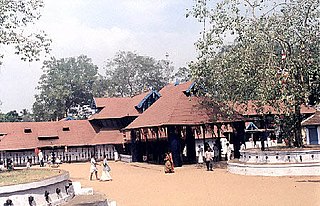
Sree Kurumba Bhagavati Temple is a Hindu temple at Kodungallur, Thrissur District, Kerala state, India. It is dedicated to the goddess Bhadrakali, a form of Mahakali or simply Durga or Aadi Parashakthi worshipped and significantly revered in Kerala. The goddess is known also by the names "Sri Kurumba"". This temple is the head of 64 Bhadrakali temples in Kerala. This Mahakali temple is one of the oldest functioning temples in India. This is attested by numerous Tamil poems and inscriptions of different times. The goddess of the temple represents the goddess in her fierce ('ugra') form, facing North, featuring eight hands with various attributes. One is holding the head of the demon king Daruka, another a sickle-shaped sword, next an anklet, another a bell, among others. Routine worship at the temple every day at 03:00 and ends at 21:00 local time.
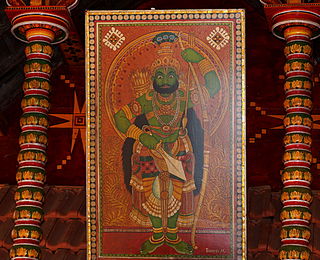
Vettakkoru Makan is a Hindu deity worshipped in parts of Northern Kerala. This deity is alternately referred as Kiratha-Sunu in Sanskrit. Vettakkorumakan is believed to be the son of Shiva by his consort Parvati, born when he assumed the form of a Kirata (hunter) to deliver a weapon known as Pashupatastra to Arjuna. He is mostly and exclusively worshipped in Malabar region of Kerala. The most famous temple of this deity is the Balussery-Kotta Vettakkorumakan temple about 25 km from Calicut. This was once the fort of the Rajas of Kurumbranad. Other prominent temples are at Ramanthali, Nileshwar, Kottakkal, Nilambur, Karaparamba and various places in Kannur district and Kasargod district. He is the family deity of the Rajas of Chirakkal, Nileshwar, Kottakkal, Nilambur Kovilakam, Kalathil Kartha's, Aluva, Amarambalam Kovilakam and Randu Illam Vargam Nambiars. Those families among the nobility of Malabar who have Vettakkorumakan as their family deity are connected in one way or other incidentally to either Balussery Fort or Kurumbranad.Later he moved to Kottanachery temple in Vellur, Payyanur in North Malabar. A special type of firecracker called "Kathina" was his favourite.

The MajorVellayani Devi Temple is a highly revered shrine in Kerala, India, dedicated to goddess Bhadrakali. The shrine is situated in Vellayani 1.5 km west of Vellayani junction, 12 km southeast of Thiruvananthapuram on the eastern bank of Vellayani Lake. The temple is under the management of Travancore Devaswom Board. The temple structure has a bronze roof with traditional art work and carries Dravidian architecture. The temple has eastern and northern towers called Gopurams with statues of different Gods sculptured in them. The Gopurams function as gateways through the walls that surround the temple complex.

The Thirunakkara Mahadevar Temple situated in the heart of Kottayam is one of the 108 revered Shivalayas in central Kerala, India. The temple is about 500 years old and was built by the Raja of Thekkumkur. It also preserves a number of unique sculptures and murals of various Hindu deities. A common belief is that the idol of Shiva here is installed by Parashurama. The Thekkumkur royal family considered the idol as their paradevatha in the form of "Thirunakkara thevar"
Velichappadu in Malayalam translates as Revealer of Light, is the oracle or mediator between a deity and devotees at a Hindu Temple in Kerala. Prominent in Valluvanad, the Velichappadu, also known as Komaram in some parts, is an integral part of the rituals in a Bhagavathi temple. There are both male and female Velichappadu and often belong to a particular family. People, in Kerala and beyond, have enormous respect for these mediating oracles when they're in their trances and heed to their words.

Avanangattilkalari Sree Vishnumaya Temple is a Hindu temple at Peringottukara, Thrissur District, Kerala state, India. It is dedicated to the god Vishnumaya in Kerala. The god is known also by the names Chathan.
Ninabali is a ritualistic performing art form popular in Kannur, Kozhikode districts of northern Kerala, India. It is a folk art performed by the Malaya community. This art form, which is performed in homes as part of Hinuist exorcism ceremonies, depicts the battle between Bhadrakali and the asura Darika.
Devakkoothu also spelled as Devakoothu is a ritualistic dance performed in Kerala, India. It is the only theyyam performed by a woman. This theyyam is performed in the temple Tekumpad Koolom Thayakav near Cherukunnu in Kannur district. The goddess associated with Devakkoothu is called Valliyamma because she stayed at a forest of creepers, according to myths. Devakkoothu is performed once in two years.
References
- 1 2 3 4 5 6 7 8 9 10 11 12 13 14 15 16 17 18 19 20 21 t, susmitha (August 2015). പറയ സമുദായത്തിന്റെ അവതരണ കലകളും സാംസ്കാരിക സത്വവും (Performing arts and cultural essence of Paraya community). Malayala Pacha Magazine. pp. 68–75.
- 1 2 Sivadas, C.D. "മലവാഴിആട്ടം" (in Malayalam). Archived from the original on 2023-03-02. Retrieved 2023-03-02.
- 1 2 Daily, Keralakaumudi. "വിളക്കാട്ടുപാടം ആറുക്കണയിൽ മലവായിആട്ടം ഭക്തിസാന്ദ്രം". Keralakaumudi Daily (in Malayalam). Archived from the original on 2023-03-02. Retrieved 2023-03-03.
- 1 2 3 Varavoor, Prashanth. "അവതരണങ്ങളിൽ അപമാനിക്കപ്പെടുന്ന അനുഷ്ഠാനകലകൾ". Archived from the original on 2023-03-02. Retrieved 2023-03-03.
- ↑ M, Athira (24 March 2022). "Malayalam docu-fiction 'Thevan' pays tribute to folk artiste Thevan Peradipurathu". The Hindu. Archived from the original on 2 March 2023. Retrieved 3 March 2023.
- 1 2 "മലവാഴി". Keralaliterature.com. 14 October 2017. Archived from the original on 2 March 2023. Retrieved 3 March 2023.